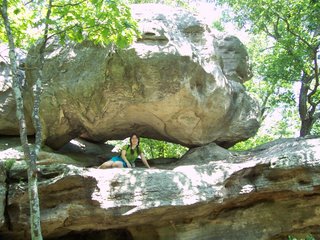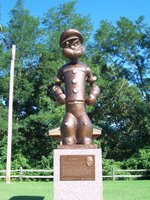How addictive is letterboxing? Read all about Lnd-Crzr’s and Fox-Fyr’s 2006 whirlwind letterboxing tour of Southeast Missouri (and southwestern Illinois), and judge for yourself. Despite the heat index of 102 degrees or higher, and no chance of rain, we set out Saturday morning July 15, 2006, with camping equipment, extra clothes, letterboxing gear, two road maps, a full tank of gas and clues to about 15 boxes scattered throughout southeastern Missouri and southwestern Illinois.
Our first stop was actually not letterboxing-related. We stopped by Hermann, Missouri (which has two LBs we visited last fall) to begin our adventure with a visit to the excellent Hermanoff Winery for a basket lunch of bread and cheese and sausage. A short detour to Deutschheim State Historic Site and a visit with its superintendent revealed an excellent opportunity to check out the town’s German heritage (and, of course, scope out some possibilities for additional LB hiding places).
Next it was down Highway 19 through Cuba, MO (home of the excellent Missouri Hick BBQ, though it was too early for dinner so we didn’t stop) and then south past Dillard’s Mill to Elephant Rocks State Park. Though the clue for the Elephant Rocks box (placed sometime in 2004 by Know Future) has disappeared from LBNA, we were lucky enough that Lnd-Crzr had visited it on his 2005 tour of the Southeast. The black 35mm film canister was exactly where he remembered it to be, and still in excellent condition, though the entries numbered only about a half dozen. Elephant Rocks State Park is Missouri’s only state park with a Braille trail, designed with guide ropes, textured walkways and Braille signage specifically for the blind visitor. Thankfully, the Braille is translated so the rest of us can enjoy reading about the giant glacial erratics. We hoped t hike its newest trail to a historic ruin, but perhaps one had to be blind to see it.
Next it was off to a remote section of the Ozark Trail near Ironton to look for the “Price’s Invasion of 1864: Pilot Knob” LB. This is another Wyld Blueberries special with a Civil War design homemade logbook and homemade stamp. This Kansas City due also planted the “Prices Invasion of 1864: Hermann” LB which we visited last fall. The Pilot Knob LB had lay quietly undisturbed in the area for about a year. We were the first finders, and Lnd-Crzr collected a nice first finder’s bonus to add to his logbook.
Since we were so close to Taum Sauk State Park, we decided to check on Lnd-Crzr’s box at Missouri’s highest point. Despite that fact that no one had used LBNA’s “Contact the Placer” link to report the box as found, there were several entries in the logbook, including an Oct.., 2005 entry from a family from Columbia, MO (Maddie, Zack and Stuart) though neither Lnd-Crzr or Fox-Fyr recalled ever seeing those names in any Columbia-area LB. Has any one seen these folks in any mid-Missouri LBs?
Fox-Fyr discovered an unexpected surprise in the Taum Sauk box: the Banana Hitchhiker (released 2004) which will soon be making its way to a box somewhere in Mid-Missouri. We didn’t have the time to checkout the other two boxes on that trail (Mina Sauk Falls and Missouri’s Hardest LB) as we were running out of daylight and wanted to reach Hawn State Park (our camping destination) before too dark. Hot and exhausted, we were fortunate enough to find a vacant campsite in the beautiful and popular Hawn State Park (which is twice the size of Rock Bridge State Park and donated to the state park system by a schoolteachrer). We set up camp and enjoyed a long shower, a quick meal, and a pleasant sleep.
Daybreak saw us up and about on the two-mile Pickle Creek Trail In Hawn which is without doubt the most popular trail in the park (since the other two main trails are four and ten mile loops). The scenery along Pickle Creek was lovely and nicely shaded with mini shut-ins, similar to Johnson’s Shut-Ins State Park but on a much smaller scale. We saw a water snake, red sunfish, a few other fish, and lots of potential for a LB series.
Our true quest, however, lay about 10 miles down the road in Pickle Spring Natural Area, an area of such incredible natural features that the area is nationally recognized. On the Trail Through Time (what a great name for a trail), we learned a new word—hoodoo—which is a term for sandstone formations which nature has shaped into fantastic forms resembling such things as such as turtles, beehives, mushrooms and giant cauliflower heads. The trail was well marked, and dunking our heads in periodic waterfalls helped keep us cool.
The box placer, Know Future, had the Pickle Springs LB listed as missing but the hike sounded

worth the trip anyway, and lo and behold, when we got to the box location, the LB was exactly where we expected it to be. Another 35 mm film canister, this one had suffered water damage, and the logbook was beyond repair. It appeared to have about six entries (including that same family from Columbia, MO who had stampedinto the Taum Sauk box). We replaced the logbook with a few sheets of paper from our own logbook, then resealed and replaced the LB for the next finder. We would have enjoyed this hike even if the box had been missing, but we were glad to have found it.

Our next jaunt took us over the border into Chester, Illinois, home of Popeye the Sailor Man (or at least of his creator). A quick stop at the Popeye Statue, which is visible as soon as you cross the Mississippi River into town, would have saved us some time as the area also contained a map of the city. Instead, we saw quite a bit of Chester as we meandered about looking for the town’s only city park. This series of six boxes was planted by the duo of Leaping Lizards from Wisconsin (who visited about 20 mid-Missouri boxes last winter). Here we ran into a bit of a struggle as east was sometimes west, and left was sometimes right, and all the trails look like game paths, some quite faint. Still, with excellent letterboxing detective work, we found four of six boxes. One was reported missing by several other finders, and the other, well who knows? Four of out six, all excellently hand-carved, was a good haul.

From Chester, we crossed back into Missouri and headed south to the middle of nowhere, aka Altenburg, to Tower Rock Conservation Area along the Mississippi. Here’s another box that even if the box is missing, the view is worth the drive. The clues led us to an overlook of Tower Rock, one of two such places named by Lewis and Clark (the other being in Montana, which is the home state of the placer, Chickenman, yet another out-of-the-region placer). (Does anyone who plants boxes in Southeast Missouri actually live in that portion of the state?) We were amazed that the box was still there, given that it was clearly visible to the casual onlooker. Perhaps not many people had ventured up to the overlook since the box was planted last April. We claimed another first finders on this box (though the main prize was the view and the photos we took). We re-hid the box so that no part of it was visible, and set off for one more for the day.
Our last and seventh box of the day took us south to Trail of Tears State Park. It’s a good thing Lnd-Crzr is not allergic to poison ivy or there was no way we were getting this one. He braved about 150 feet of thick, waist-high poison ivy to recover this box (and had to venture back through it to replace it). It’s a good bet that a Muggle is not going to accidentally run into this LB and steal it anytime soon. It’s a good thing we planned on camping that night so Lnd-Crzr could avail himself of the showers. As it was Sunday night, the campground was just about deserted except for the few hundred mosquitoes zeroing in on the few remaining campers.
Monday morning began with a visit to the Trail of Tears visitor center to learn about the Native American tribes who passed through the area on their forced march to Oklahoma (hence the name Trail of Tears). Fox-fyr had a pleasant chat with one of the state park staff members who plans on planting a letterbox in her park as soon as she finds a good location and carves her first stamp.
Next it was off to Jackson, Missouri, to search for yet another of Chickenman’s boxes (he also planted Trail of Tears). The hunt led us to old McKendree Chapel, a remarkable building built in 1800 a few years before Lewis and Clark passed through the area, and when the region was still governed by Spain. This was yet another location we would likely have never visited had not been for the fact that a letterbox had been planted there. While it took us awhile to find the signs directing us to the chapel, we were well rewarded by the quality of the site. The chapel was unlocked and open to the public and judging by the guest book, a popular place for weddings. The site is also home to two of the state’s champion trees.and an old log cabin, whose story was preserved in a brass plaque. Again, our luck held out, and the box was exactly where it was supposed to be, guarded by a few spiders and webs. Our fourth first finders this trip.

Though it was late morning, and our bellies were reminding us we hadn’t yet had much breakfast or any lunch, we set off for Bollinger Mill and Bufordville Covered Bridge State Historic Sites to search for another box planted by Chckenman. We got a personal tour of the four-story Bollinger Mill (took advantage of the July special: buy-one-tour, get-one-free) and went back in time to days when the industrial revolution was young, and the machinery surprisingly advanced. We learned the origin of the phrase “show your mettle” (people who “dressed” or shaped grinding stones often received small chips of stones in their hands. A “dresser” looking for work would often be asked to “show his metal” to indicate how much experience he had.).
While the tour of the mill was excellent, our luck in finding the box was not so good. We searched some likely hiding places for about 30 minutes before concluding that it was probably missing.
Still we had some daylight left, so off to Johnson’s Shut-Ins State Park (with a quick side trip for pork tenderloin sandwiches, fried clams, friend mushrooms and ice cream and yet another black cherry vanilla coke from the cooler). Black Cherry Vanilla may replace Rootbeer as the drink of choice judging by the amounts we consumed in three days.
No letterboxes hidden at JSI, but lots of memories and the awesome view of the destructive power of billions of gallons of water harnessed for power but breaking free from its artificial enclosure. When the AmerenUE dam broke last December, it sent a flood of water rushing down the mountainside into the park, leaving a swath of destruction in its path. We both had visited the park prior to the dam breaking, and the difference was amazing. Of particular interest were the yellow bands park staff had placed in the trees to show the height of water in the park during the flood,andthesheer amount of trees missing. What was once forest was now stripped to basically bare rock.
We left Johnson’s Shut-Ins in the late afternoon, with Fox-Fyr vainly attempting to steal back

her carkeys from Lnd-Crzr who had apparently had enough of Fox-Fyr’s inability to drive smoothly around the winding, twisting backroads of the southeast. With Lnd-Crzr now at the wheel, we set off for one last letterbox at Beaver Creek Conservation Area. As we neared the area, Lnd-Crzr recalled that he had actually visited this box before almost exactly a year ago. Perhaps he will make this an annual pilgrimage. A pretty easy find, with only about half a dozen entries, the last being from a pair of Muggles out walking their dog who happened accidentally upon the box.
All-in-all, as we headed back to Mid-Missouri and the Land of Plenty, about 700 miles and two tanks of gas later, we marveled at our luck: we found 12 of the 15 boxes we’d searched for, many of them more than two years old, plus a Hitchhiker and four first finders. In addition, Fox-Fyr hit her 100th box found on this trip, and Lnd-Crzr reached about 106 finds. A thoroughly excellent adventure. Addicted? We certainly are.
Fox-Fyr
Side Note: I (Lnd-Crzr) did a SE MO LB Tour 2005 and found only about half of the 8 or so LBs I looked for. SE MO is certainly one of Missouri's richest regions for historical and natural sites. I've spent a many days, over many years exploring this region and feel I have only scratched the surface of what it has to offer. Now it appears that it is also becoming a worth-while trip for die-hard LBers. If you're ever in search of an erea to explore, I highly reccommend south east Missouri. I'd be happy to point out some hightlights and must sees if anyone is interested.
Article written by Fox-Fyr with pictures and publishing by Lnd-Crzr.






